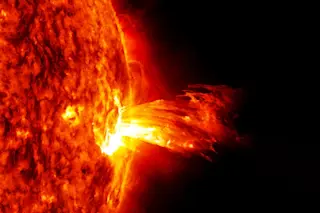A bright comet fell into the sun on October 2, 2011 in synch with a coronal mass ejection bursting out on the other side. Credit: ESA/NASA/LASCO C2
The National Academy of Sciences has estimated that a major solar storm could cause $2 trillion in damages, frying GPS satellites and short-circuiting electrical grids. Many of those storms originate at sunspots, dark blemishes on the sun’s surface that are wellsprings of magnetic activity. But help is on the way: Last August scientists reported the first successful predictions of individual sunspots days before they appeared, opening up the possibility of accurately forecasting severe space weather.
Astronomers have been able to forecast trends in the number of sunspots since the 1800s, but predicting individual spots requires satellites that can probe the turbulent plasma flows deep beneath the sun’s surface. Remotely controlling instruments aboard the Solar and Heliospheric Observatory spacecraft, located a million miles from Earth, researchers led by Stanford astrophysicist Stathis Ilonidis tracked the motion of sound waves bouncing around the sun’s interior. Ilonidis’s team noticed that the waves sped up when passing through certain regions of turbulent, electrically charged plasma. Those regions, as far down as 40,000 miles, turned out to be brewing sunspots, which surged up to the solar surface a day or two later.
Ilonidis says that the fastest-rising sunspots carried the strongest magnetic fields, giving scientists a criterion for identifying the most serious threats. Within a few years, automated sunspot predictions could allow engineers to protect the grid and place satellites in safe mode ahead of a major solar outburst.
In Related News
After a quiet four years, the sun became more active last year, hurling several flares of high-energy particles into space, some directed toward Earth. A solar storm in October produced colorful auroras as far south as Arkansas.














